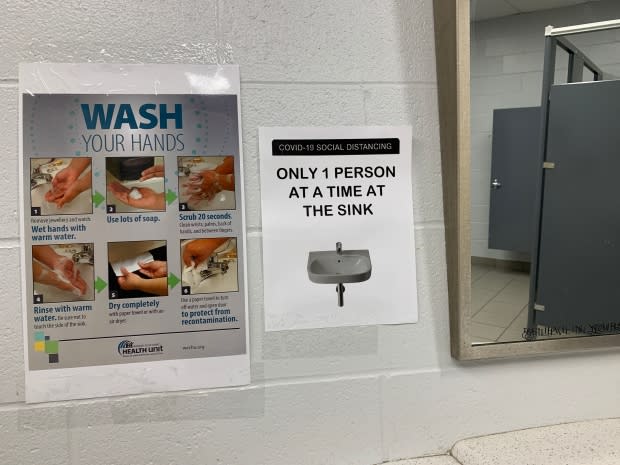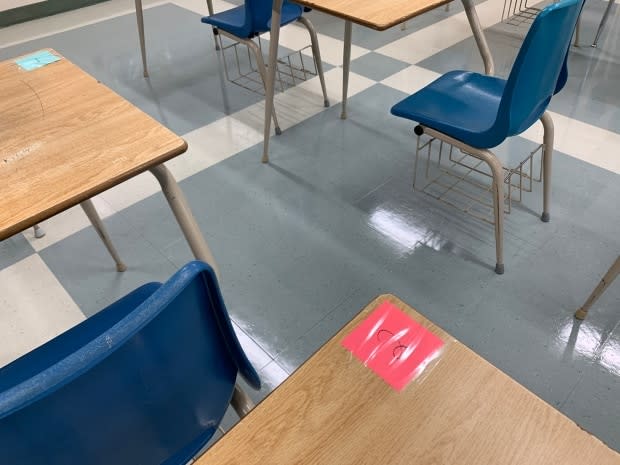Here's how some Catholic schools in Windsor-Essex will look in the era of COVID-19

Directional arrows in hallways, bottles of hand sanitizer and designated seating are just some of many changes the Windsor-Essex Catholic School Board unveiled Thursday as it gave a tour of elementary and secondary schools in the region.
With students expected to return to class after Labour Day long weekend, schools have started implementing safety measures to protect against COVID-19.
The Catholic school board said it is using a "risk reduction strategy" that includes arrows directing movement in hallways, physical distancing measures, cohorting of students, mandatory mask-wearing for grades 4 and up, hand hygiene and increased cleaning of buildings.
The school board said Thursday that each of these strategies may look a bit different as principals adapt it for their specific building.
'New norms' for younger students to learn
At St. Joseph Catholic Elementary school in Amherstburg, principal Linda DiPasquale and school board superintendent Melissa Farrand said there will be a number of "new norms" that kids will have to adjust to.

One strategy being implemented at St. Joseph, DiPasquale said, is to assign students colours so that only a small number will perform an activity at one time.
For example, DiPasquale said all the red students will be asked to go to the coat rack, meaning only those assigned the colour red will be up, allowing students to physically distance.
But she said she anticipates teachers will come up with other creative ways to encourage physical distancing.
Physical distancing for children will be one metre, as based on recommendations from Sick Kids, DiPasquale and Farrand said.
Outdoor learning, making hand-washing part of the daily routine and having individualized belongings are a few other strategies primary teachers will be enforcing.
Extra custodial staff will also be on site to clean high-touch surfaces, DiPasquale said.
"We can anticipate that some students will need support in realizing those typical hugs or high fives or handshakes are not now the norm, however we do know that play and socialization is critical to children's development so that's why we have so many measures in place," Farrand said.

Parents will also be expected to screen their children to ensure they are healthy every morning before leaving for school.
Farrand said staff anticipate that by next week the board will know how many parents will be sending their child to school through a registration form that is being sent out.
High schoolers in cohorts, 2 periods per day
While elementary students are able to attend school full-time, every day, high school students attending classes in person will be placed into cohort A or cohort B.
These cohorts will attend school on different days that will rotate each week.
At St. Thomas of Villanova Catholic High School in LaSalle, principal Amy Facchineri and the board's executive superintendent of education Emelda Byrne discussed why students are being cohorted.

Facchineri and Byrne said this type of separation will help reduce the number of stundents in the school at one time and help with contact tracing if an outbreak occurs.
Also, rather than four periods in a day, students will only have two and each will be about 150 minutes long.
For these reasons, desks will be labelled as "period 1" or "period 2," so that when students switch classrooms, they will sit at different desks and cleaning will take place in-between classes, Byrne said.
Special classrooms, such as those used for construction, auto, culinary, science labs or cosmetology, are still under review to allow for appropriate physical distancing, she said.
Byrne added that the length of the school day is still unclear, so they aren't sure if a regular lunch or two nutritional breaks will be scheduled — this will also influence if the cafeteria will be used.
By next week, Byrne said staff will have to confirm their in-person presence and high school parents will have to indicate whether their children will be attending classes in-person or online.
School ventilation questioned
Retired radiation oncologist Christopher Leighton sent a letter to school boards on Aug. 5 saying he wants to see class sizes reduced and would like Windsor-Essex school boards to address building ventilation.
"The data has been emerging gradually and now it's become more, I think, very convincing, that airborne or suspended aerosol transmission is an important route of transmission for the coronavirus," Leighton said.
For this reason, he said he's concerned about schools with poor ventilation.
"If you have 30 children just one of whom is infected, in a closed classroom for hours, exhaling just at regular respiration rate," he said. "If there is not ventilation you are posing a great risk to the remainder of the group there and especially the teacher."
Additionally, he said that class sizes should be reduced to ensure that physical distancing can take place.
When CBC news asked the Catholic school board about ventilation in its buildings, the board's spokesperson said a complete assessment of all of the school's HVAC systems had been done, "to make sure that they are in excellent working condition."



